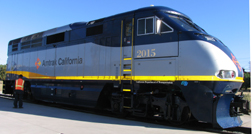A concluding thought in “Road expansion or repair: Can either do anything to lower burden on air?” (Part 1) had to do with whether road-based projects – expansion or repair thereof – could have “an air-remedying effect.” Affirmative is the answer.
Though “yes,” it’s conditional. A new overpass used to replace a physical intersection, for example, obviously eliminates a situation where intersecting traffic must be managed, whether via signage, electronic signalization or roundabouts, and, as such, traffic entering a point on two different planes, never actually physically cross paths, so there is no direct interaction one vehicle to the next on the two levels. But more importantly, when it comes to sparing the air, continuously moving traffic through such a grade separation could very well make less of a negative-air impact.
So, on a recent edition of CBS This Morning, featured was a segment on which passenger train transportation in Tokyo and in Japan was profiled. The segment reporter reporting observed that half of Tokyo’s commuters commute by rail. And, why not?! The Tokyo-based passenger rail transportation systems are so well run and so well maintained it is no wonder that Tokyo rail-commuters so love the trains. Based on what was aired, it is difficult to imagine train travel anywhere else in the world rivaling this. Add to it all the spotless stations, and for the train traveler, that’s like having one’s cake and eating it too, though trains can get crowded at times; standing room only, in other words. Japan is for all intents and purposes the exception here.

Not all modes created equally
Using high-speed train travel as an example, it just doesn’t get any cleaner than this.
From the “For National Transportation Week, road, rail, air compared” Air Quality Matters blogpost of May 15, 2014, with respect to four out of five pollutant emissions, trains simply upstaged cars. Autos did one-up the high-speed trains, however, in one air-pollutant category only – sulfur dioxide (SO2). It is assumed that the trains though powered by electricity, that electricity was probably generated mostly if not entirely using non-renewable, non-sustainable fuels.
Here is an excerpt from that post.
“One of the chief considerations when discussing transportation is the quantification of emitted pollutants; in other words, how much of what type of pollutant is being emitted one mode compared with others? For illustrative purposes, compared are airplane (A), car (C) and high-speed train (HST) for the following pollutants: Carbon dioxide (CO2), particulate matter (PM), sulphur dioxide (SO2), nitrogen oxides (NOx) and non-methane hydrocarbons (NMHC).
“The information below is referenced from [High Speed Trains and Sustainability,] ‘Figure 11 A modal comparison of air pollutant emissions,’ [from the International Union of Railways, Nov. 2011, p. 22]. Please keep in mind CO2 is measured in kilograms (kg) while all other pollutants are measured in grams (g). Please also note that the Frankfurt to Hamburg route in Germany was selected and the ‘Characteristics and components’ are expressed in ‘units per person travelling.’
- “CO2 – 77.1 (A), 86.0 (C), 19.2 (HST)
- PM – 2.1 (A), 21.2 (C), 1.0 (HST)
- SO2 – 43.4 (A), 3.2 (C), 19.5 (HST)
- NOx – 268.3 (A), 223 (C), 17.2 (HST)
- NMHC – 20.8 (A), 18.3 (C), 1.1 (HST)”
The verdict? Clearly the winner here is high-speed trains. This is the advantage that rail infrastructure has over roadway infrastructure.
Though the irony in all of this is that the more sustainable, efficient and air-friendly of the two modes is the less-traveled one. That it is this way is counterintuitive. It just defies logic!
Images: California Environmental Protection Agency Air Resources Board (upper); W. R. Howell, Jr. (lower)
This post was last revised on Dec. 27, 2020 @ 9:34 a.m. Pacific Standard Time.
Published by Alan Kandel

Quote: ”
Please keep in mind CO2 is measured in kilograms (kg) while all other pollutants are measured in grams (g).”
CO2 or Carbonic Acid is not a pollutant. It is plant food.
A Science blog should know the difference.
It seems not everyone would agree. Please reference the online National Geographic article: “Air Pollution, Explained: Pollutants in the air aren’t always visible and come from many different sources,” written by writer Christina Nunez.